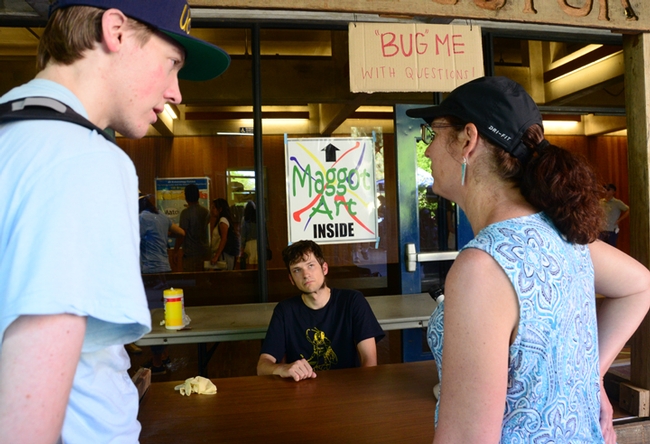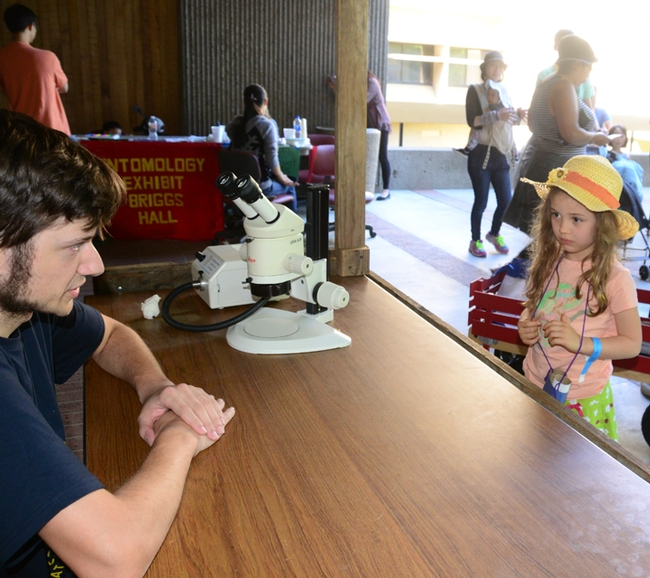
And attendees did. They asked questions, expressed concerns, and offered comments.
Members of the UC Davis Entomology Graduate Students' Association, headed by president Brendon Boudinot, fielded scores of questions from 9 a.m. to 4 p.m.
"Bug Doctor" Boudinot, a doctoral candidate who studies ants in the Phil Ward lab and who co-chaired the UC Davis Department of Entomology and Nematology's Picnic Day Committee, remembers that a little girl asked him "Do bugs get ear infections?"
That was Lilliana Phillips, 5, of Carmichael, who stood in line with her father, William Phillips, a UC Davis alumnus (bachelor's degree in environmental toxicology and master's degree in pharmacology toxicology.
"Good question," Boudinot told her as the crowd smiled.
"I had to think about that one for a while," Boudinot later related. "My best answer is that perhaps mantises, grasshoppers, and cicadas do, as they all have 'ears' (tympana), albeit in different places on their bodies!"
Other questions zeroed in on evolution, insect control, mosquito hawks and butterflies.
"I had a long conversation with an undergraduate about the evolutionary descent of insects and their arthropod kin," Boudinot said. "We discussed the origin of the Arthropoda, the reason why Paleozoic insects were so large, and a number of other topics."
Another undergraduate, a math and economics major, asked Boudinot about the use of differential calculus in his research.
"A number of people asked about insect control, and some even asked plant control questions," Boudinot said. "One woman and her family asked me about 'mosquito hawks.' I informed her that these large flies are not predatory, and have grub-like larvae which feed on decaying material, among other aspects of their natural history."
Another student quizzed him about his knowledge of the color blue in the insect world. "We talked about structural colors. I was unaware that there is a genus of butterfly, Nessaea (Nymphalidae), which has true blue pigmentation--an extreme rarity in the natural world!" (According to Wikipedia, unlike virtually all other butterflies with blue coloration, the blue colors in this genus are due to pigmentation rather than iridescence--for example, Morpho species.)
One young boy asked if mosquitoes will ever go extinct. "I told him that mosquitoes will certainly not go extinct in our lifetime. However, there are many many species of mosquitoes which do not bite people, and if he wanted to learn more about them, he could ask the Sacramento-Yolo Mosquito and Vector Control District folks (in the nearby booth).
"The final, long conversation I had was with an engineer who was fascinated by insect anatomy and physiology. The conversation started with the mechanism for insect breathing, led through heart and gut anatomy." Boudinot then headed to Briggs 158 to use the chalkboard to explain how the insect cuticle has a machine function.
The next "Bug Doctor" in the rotation was Zachary Griebenow, a first-year Ph.D. candidate in the Phil Ward lab.
The little girl who asked the "Do bugs have ear infections?" also asked him for his take.
"I said that I doubted it," Griebenow related, "as the auditory organs insects have are chordotonal: essentially, they consist of a scolopidiform sensillum attached to cuticle at both ends. Therefore, as there is no fluid involved, the idea of an infection attacking such a structure seemed unlikely to me."
"Another individual asked me to explain the distinction between arachnids and insects, which I did as one might expect (differences in tagmosis, appendages, etc.)"
Lastly, Griebenow was asked whether insects "answered to the same God as we do." He responded that he did not have the authority or knowledge to answer the question.
UC Davis entomology graduate students, including Boudinot, are accustomed to answering entomological questions. Boudinot served as a member of the UC Davis Department of Entomology and Nematology's Linnaean Games Team that won the Entomological Society of America's national championship twice: in 2015 and 2016. The ESA Linnaean Games are a lively question-and-answer, college bowl-style competition on entomological facts played between university-sponsored student teams. The teams score points by correctly answering random questions.
Some of the questions the UC Davis team, captained by Ralph Washington Jr., successfully answered in the 2016 competition:
- Question: “You have just moved into an apartment that has been vacant for weeks but whose prior owners had several cats and dogs. A very few days after you move in you are bitten by a huge number of cat fleas that seem to have appeared out of nowhere. What characteristic behavior of cat fleas biology is probably responsible for this?” Answer: “Cat flea pupae eclose in response to the presence of a host.”
- Question: Insects inhabiting a very thin water film such as splash zones marginal to streams are called what?
Answer: Madicoles - Question: The insect order Notoptera unites what two former insect orders?
Answer: Notoptera unites Mantophasmatodea and Grylloblattodea - Question: What are the two obvious clinical symptoms that someone is suffering from onchocerciasis?
Answer: Blindness and hanging tissue around lymph nodes, often times the scrotum. - Question: What is the common name for the zygentoman pest that thrives in high humidity and high temperatures and is often found in boiler rooms?
Answer: The firebrat, Thermobia domestica. - Question: Projection neurons travel across what two major regions of the insect brain?
Answer: The protocerebrum and the deutocerebrum
Click on the YouTube video to see the champion round of the 2016 Linnaean Games.
Attached Images:

Bug Doctor Brendon Boudinot answers a question from Lilliana Phillips, 5, of Carmichael, as her father, William Phillips, watches. (Photo by Kathy Keatley Garvey)

Doctoral candidate Brendon Boudinot of the UC Davis Department of Entomology and Nematology fields a question from a "client" at the Bug Doctor booth at the 104th annual UC Davis Picnic Day. (Photo by Kathy Keatley Garvey)

Ant specialist Zachary Griebenow, a first-year doctoral student in the Phil Ward lab, answers a question in the Bug Doctor booth. (Photo by Kathy Keatley Garvey)

Lilliana Philips, 5, of Carmichael, listens intently as Bug Doctor Zachary Griebenow answers her question: "Do bugs get ear infections?" (Photo by Kathy Keatley Garvey)